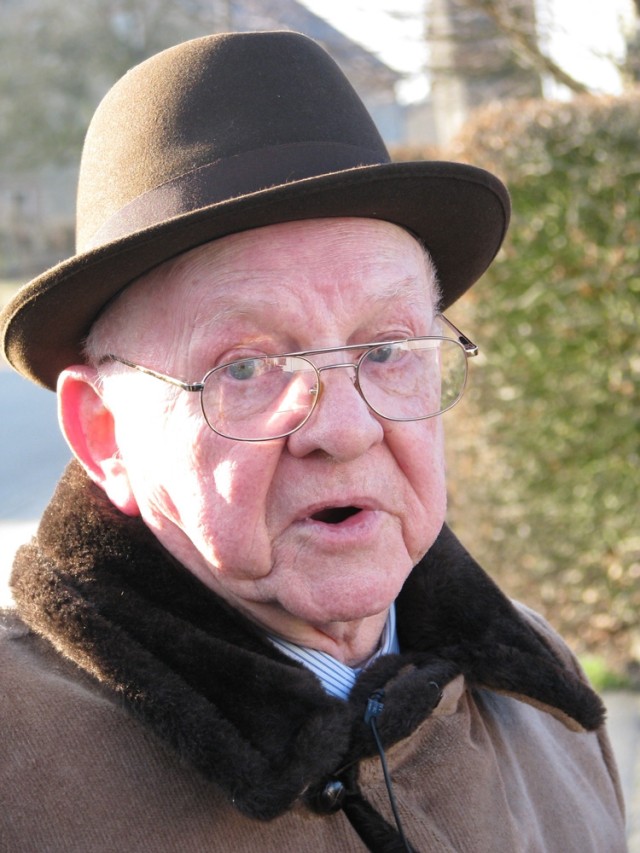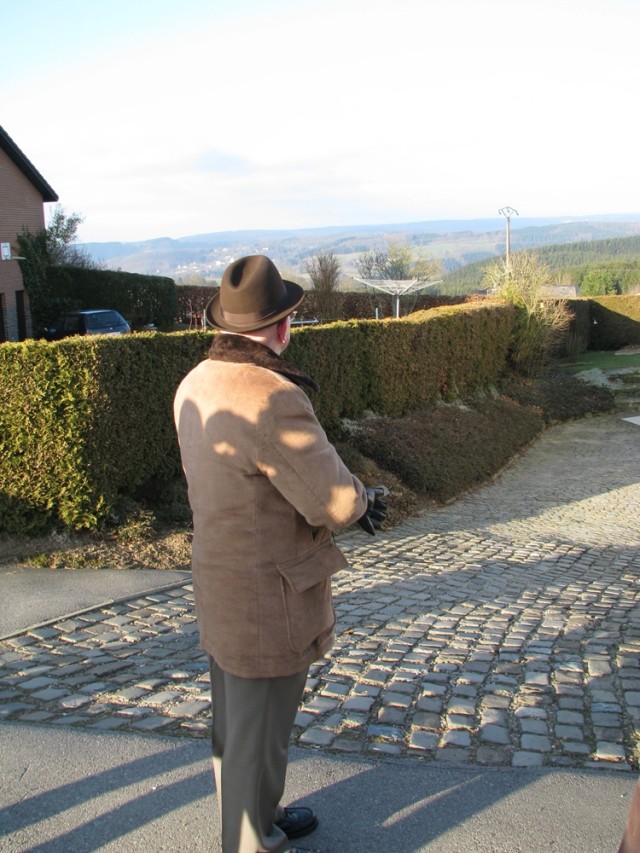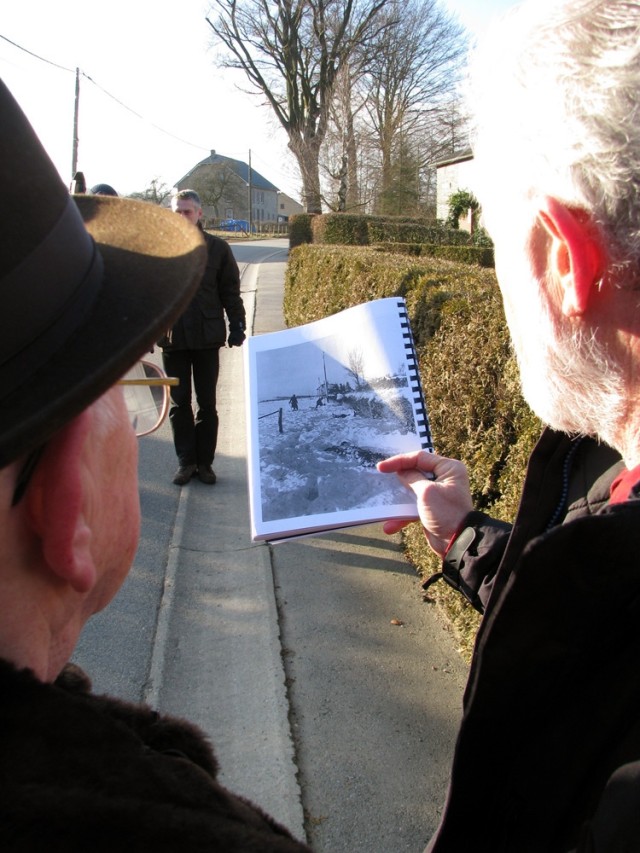BAUGNEZ, Belgium - Sixty three years after Nazi Waffen SS troops mowed down 84 members of his unit in cold blood, survivor Ted Paluch walked the hallowed Belgian ground where his friends had lost their lives, and he had lost his youth.
Now a guest of honor during a Dec. 17 Belgian ceremony and museum dedication that coincided with the anniversary of what came to be known as the MalmAfAdy Massacre, the spry 84-year old had come a long way since that December day in 1944, when he was a corporal with the 285th Field Artillery Observation Battalion.
His unit - moving to new positions near St. Vith in response to the last-ditch, surprise Nazi offensive in the Ardennes - suddenly found itself surprised and under fire from German tanks and halftracks at the formerly peaceful Baugnez crossroads, less than two miles southeast of MalmAfAdy, Belgium.
Despite having borne witness to one of the most notorious war crimes ever committed on American prisoners of war, he downplayed his emotions as he recounted his amazing tale of survival.
"I've been back two other times, I was here in '96 and '76, and I'm not as emotional now as I was then," he remarked. "I was in a convoy right across the street here, maybe 10 yards down the road, and a [German] tank came around, and there was a lot of firing and a lot of shelling. We got out and were shooting, but didn't know what we were shooting at, they didn't either I guess."
Having dismounted the vehicles and taking cover in ditches alongside the road, Paluch recognized the troops as members of the vaunted SS by the distinctive skull and crossbones and lightning insignia on their collars. They represented the advance units of the 1st SS Panzer Division, known as Kampfgruppe (Attack Group) Peiper, after their leader, SS Lt. Col. Joachim Peiper, a highly decorated veteran of campaigns in France and Russia.
"There were three of them behind the tank; they came down, and we were in the ditch, a ditch that is up to my neck," he related. They pulled down the road here and lowered the tank gun on us, and what could you do' We had carbines, so we just surrendered."
Paluch related that the initial treatment at the hands of the SS gave no clues about what lay in store for the prisoners, and even offered an amusing recollection. "They and they marched us up here to the crossroads, they searched us, they took anything of value, cigarettes, watches, and I had a pair of socks and they even took those," he exclaimed incredulously.
Along with members of his unit and others caught off-guard at the crossroads, the group of prisoners was herded into a field at the crossroads to await their fate. They had no warning of what would transpire next.
"Then one command car came up and took a couple shots, and every tank and halftrack that came around the corner shot into the group," he said. "I was real lucky, as I was in the front end and only got hit slightly, but I think when they came around they fired into the center of the group."
Pausing to catch his breath, he glanced over his shoulder and hesitated, almost as if reliving the moment in slow motion, before beginning again.
"This was their front line over here at one of these houses, and then anyone that moaned, they came around and they shot. I played dead and just lay there," he said.
Paluch and some of the other survivors, hearts racing, many wounded, listened motionless as the sound of a large German mechanized column sped past. After what seemed an eternity, but from survivor reports was probably more like an hour or two, "all the trucks and halftracks passed and it was a little quiet," Paluch recalled, his profound relief still evident after the lapse of 63 years
"I didn't know where they were headed, they didn't tell me, and I just wanted to know how to get out of there," he smiled.
It was about 4:30 p.m. and starting to get dark. With the noise of the column fading in the ears of the survivors who lay in the field among their dead and dying comrades, many leapt to their feet and raced for the tree line. As survivors sprinted for cover, a number were engaged by German infantry still stationed in the vicinity of the crossroads, killing at least 10.
In what was to be a life full of lucky breaks, Paluch jumped up and ran down a dirt road along with several others. At the crossroads, a German with a pistol appeared and shot at him twice, and missed. Reaching a hedgerow, Paluch recalled vividly the sound of an inferno, which was a pub at the crossroads that had earlier been set afire because it harbored American soldiers.
"Up there was a dirt road and a hedgerow back there, but there were no houses at that time, and there was a cut in the hedgerow. I crawled through a big hole in the hedgerow and I lay here as still as I could," he related as he walked to the spot, where the driveway to a Belgian house now sits. "I watched the Germans come out of the house over there and pump some water."
Ironically, he walked to the exact spot where the long-removed pump previously stood, and knelt down to reveal the only evidence, a flange in the ground covered by a simple plastic cover.
Concerned he might be discovered, he waited for the voices to subside.
"I rolled over so they couldn't see me from the house up here, went that way and hit the railroad," he said, pointing down a steep embankment that would have shielded his escape from Germans still at the crossroads. "That's when I met Matera from our outfit - who was shot in the foot - and two other fellas', Anderson and someone named Johnson. We walked into Malmedy together along the railroad track."
Upon stumbling into American units, they were met by the incredulous, horrified expressions of American officers as they related their tale.
"When we met up with a unit, we could have had anything we wanted, morphine [if wounded], anything, that's when we were scared, that's when we realized what happened," he admitted.
News of the massacre, relayed by Paluch and fellow survivors who stumbled into American lines, spread like wildfire among American units. Within two days, it is said, shocking news of the massacre solidified American resolve and convinced soldiers that surrender would never be considered.
In the end, stalwart American defense, in part buttressed by the intense anger incited in American troops by news of the Malmedy Massacre, crushed the fanatical German offensive. Paluch returned to Philadelphia, where he has remained, and thrived ever since.
The continued respect and admiration of ordinary Belgians towards Soldiers, past and present, remains a constant. After all the years that have elapsed, throngs of Belgian citizens, young and old, turned out to get a glimpse of Paluch, shake his hand, and in their small way demonstrate their appreciation for the sacrifice of Soldiers who won their freedom so long ago.
"We are deeply thankful that if we know that we live in a free world and a democracy, it's because 84 young people coming from vary far away were killed here fighting for the Belgian people," said Jean-Paul Bastin, mayor of MalmAfAdy. "We know also that the fortunate ones who survived were touched forever. We will never forget."
Sixty-three years after being witness to history, tears welled up in Ted Paluch's eyes as he laid a wreath at the spot of the massacre, and it was clear that he had no intention of forgetting either.






Social Sharing